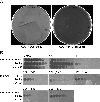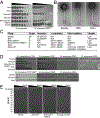Engineered bacteriophages for treatment of a patient with a disseminated drug-resistant Mycobacterium abscessus
- PMID: 31068712
- PMCID: PMC6557439
- DOI: 10.1038/s41591-019-0437-z
Engineered bacteriophages for treatment of a patient with a disseminated drug-resistant Mycobacterium abscessus
Abstract
A 15-year-old patient with cystic fibrosis with a disseminated Mycobacterium abscessus infection was treated with a three-phage cocktail following bilateral lung transplantation. Effective lytic phage derivatives that efficiently kill the infectious M. abscessus strain were developed by genome engineering and forward genetics. Intravenous phage treatment was well tolerated and associated with objective clinical improvement, including sternal wound closure, improved liver function, and substantial resolution of infected skin nodules.
Conflict of interest statement
Competing Interests
Dr. Schooley serves as an uncompensated member of the AmpliPhi Scientific Advisory Board. Other authors declare no competing interests.
Figures







References
Publication types
MeSH terms
Grants and funding
LinkOut - more resources
Full Text Sources
Other Literature Sources
Medical

